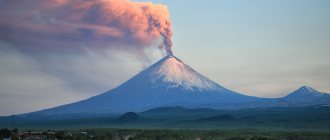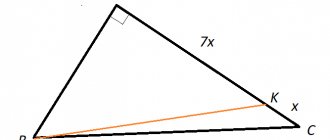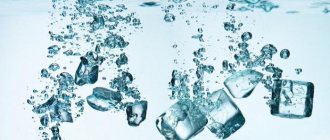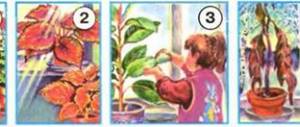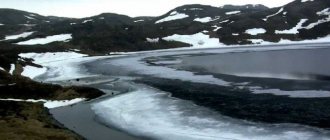How have ideas about the shape of the Earth changed?
In Ancient Greece in the 9th-8th centuries. BC e. (the time of Homer) The earth began to be represented as a convex hemisphere, similar to a warrior’s shield. The Greeks believed that the land was washed on all sides by the ocean.
The idea of the Earth and the Universe in the time of Homer
Pythagoras and his disciples (6th century BC) proclaimed the Earth to be a sphere. It is believed that Pythagoras borrowed this knowledge from the Egyptian priests, who, unlike the philosophers of Ancient Greece, hid their discoveries. But he could not prove his hypothesis. The first evidence of the sphericity of the Earth was given by Aristotle (IV century BC). Some of them are absolutely true, others are wrong. We'll talk about this later. Aristotle proved that the Earth is a sphere with the following observational results:
- during lunar eclipses, no matter which side the Earth is turned, its shadow on the surface of the Moon is always round, and only a ball can always cast a round shadow;
- ships, sailing into the distance, do not gradually move away, remaining completely visible, but almost instantly “sink” beyond the horizon;
- when raised, the horizon expands;
- When moving along the meridian, the visible stars in the sky change: some stars can be seen from some regions of the Earth, while in others they are never visible.
Evidence of the sphericity of the Earth according to Aristotle
Over time, ideas about the sphericity of the Earth began to be based not on observations, but on precise calculations. The ancient Greek scientist Eratosthenes (III-II centuries BC) was the first to calculate the size of the Earth. He calculated the arc length of the 1° meridian.
Eratosthenes noticed that in Syene (Aswan) on the day of the summer solstice (June 21), the Sun illuminates the bottom of the deepest wells, therefore it stands at the zenith and the angle of incidence of its rays is 90°. In Alexandria at this time the Sun is at an angle of 7°12′ from the zenith, which is 1/50 of the circle. By measuring the distance between Syene and Alexandria and multiplying by 50, Eratosthenes calculated the length of the Earth's meridian, and therefore its radius. The dimensions he obtained differ from the results of modern calculations by less than 25 km.
Calculations of Eratosthenes of Cyrene
Consequently, the scientists of Ancient Greece had generally correct ideas about the shape and size of the Earth. But their geographical maps were imperfect due to lack of knowledge and little exploration of the land and ocean at that time.
In the Middle Ages, until the 15th century, due to the dominance of the church, most of the scientific knowledge of the ancient peoples was denied. After the destruction of the Alexandrian library, almost all scientific work was interrupted. The doctrine of the sphericity of the Earth was considered a heresy and was categorically rejected. Measurements of the length of the meridian were carried out anew by the Arabs and Chinese, and they were rediscovered by Europeans, thanks to the knowledge gained from these peoples.
European ideas about the shape of the Earth in the Middle Ages
At the end of the 15th century. The Renaissance began, and soon there was an intensified catch-up of knowledge in all scientific fields of that time. The coming era of great geographical discoveries expanded the horizons of the Earth.
- H. Columbus, trying to find a western route to India, discovered the New World (America) in 1497.
- Vasco da Gama paved the way to India around Africa (1497).
- F. Magellan and his team completed the first circumnavigation of the world (1519-15220).
The maps became more and more accurate and detailed, and there was no longer any doubt about the shape of the planet. The earth was “recognized” as a ball and began to be depicted in the form of a three-dimensional model – a globe. The first globe had a diameter of 0.5 m and was made in 1492. It was made by Martin Beheim, a German navigator and scientist.
"Earth Apple" by Martin Behaim
Due to the development of knowledge about the Earth, ideas about its shape have improved. At the end of the 17th century, thanks to the work of I. Newton, the assumption arose that the Earth, due to axial rotation, should be compressed from the poles. The rotation of the Earth is affected by the force of gravity and centrifugal force, the magnitude and direction of the force of gravity depends on the addition of these forces. At the pole, the centrifugal force is zero, so the force of gravity is equal to the force of attraction and its magnitude is greatest. At the equator, centrifugal force increases and gravity decreases. The resultant force of attraction and centrifugal force - the force of gravity - is directed towards the equator. Under its influence, the mass of the planet moves towards the equator, and the Earth takes on the shape of an ellipsoid .
This theoretical assumption was confirmed by the following fact. In 1672, astronomer J. Richet was sent from France to Cayenne (French Guiana) to study Mars in the year of the Great Confrontation. He took with him a clock whose pendulum beat the seconds, i.e. the period of swing of the pendulum was equal to one second. In Cayenne, the clocks began to lag and the length of the pendulum had to be shortened. The clocks began to rush in Paris. I. Newton explained the slowdown in the swing of the pendulum when moving it from temperate to equatorial latitudes by a decrease in gravity due to an increase in centrifugal force. To measure the arc length of the 1° meridian, the French Academy of Sciences in the 19th century. sent two expeditions: one to the Arctic Circle, the other to the equatorial regions. At the pole, the length of the meridian turned out to be 11.7 km, at the equator – 110.6 km. Newton's hypothesis was proven.
A sphere uniformly flattened at the poles is called a spheroid , or ellipsoid of revolution . The compression of the Earth is small; its equatorial radius is only 21.4 km longer than the polar one.
Dimensions and shape of the Earth. Ellipsoid of revolution
But the true figure does not completely correspond to the ellipsoid of revolution. An ellipsoid of revolution is a regular figure that appears when a body that has a homogeneous structure rotates. The figure of the Earth is more complex due to the heterogeneity of its composition and uneven distribution of masses. In 1873, I. Listing introduced the word “geoid” to refer to the name of the Earth’s figure.
The true geometric figure of the Earth was called the geoid (“Earth-like”). A geoid is defined as a figure whose surface is everywhere perpendicular to the direction of gravity, i.e., plumb. The surface of the geoid coincides with the level surface of the World Ocean. The rise and fall of the geoid above the ellipsoid is plus or minus 50-60 m.
Geoid
The size and shape of the Earth and its other characteristics
The true surface of the Earth with all its mountains and depressions does not coincide with the surface of the geoid and recedes from it by several kilometers. The actual surface of the planet with its mountains and depressions is constantly subject to the force of gravity, which tends to level it and bring it into conformity with the level surface.
Work on calculating the size of the Earth, carried out under the direction of F.N. Krasovsky (1940-1946) showed that the difference between the geoid and the spheroid is small, and for cartographic and geodetic work in the USSR, the values of the earth's ellipsoid were adopted, named after the leader of the research. The dimensions of Krasovsky's ellipsoid are as follows:
- equatorial radius – a=6378.2 km;
- polar radius – b=6356.8 km;
- polar compression - (ab):a =1/298;
- meridian length – 40008.5 km;
- equator length – 40075.7 km;
- Earth's surface area is 510 million km².
When analyzing satellite images of the Earth, it turned out that the northern polar radius is 30-100 m larger than the southern one, which differs slightly from the Krasovsky ellipsoid data and has no significance for practical application. But thanks to clarification of the dimensions, it turned out that the Earth has a cardioid . However, for the analysis of most geographic processes, the Earth can generally be taken as a sphere.
Landforms or morphostructures
There are such large and small landforms as
- continents are the largest forms; scientists believe that there was once only one continent, the gradual division of which led to the modern appearance of the Earth;
- oceanic basins are also a large form of earth's relief, formed due to the movement of lithospheric plates; it is believed that once there were fewer oceans on earth, and after hundreds of thousands of years the situation will change again, perhaps some parts of the land will be flooded with water;
- mountains are the most grandiose forms of the earth's relief, reaching enormous heights; mountains can form chains of mountains;
- highlands - isolated mountains and ridge systems, such as the Pamirs or Tien Shan;
- shelves - areas of land completely hidden under water;
- Plains are the flattest possible surface of the earth, the best place for human life.
Fig 1. Relief of the Earth
Such forms have a specific name - morphostructures. Scientists distinguish between such types of morphostructures as planetary and regional, which formed later. Tectonic movements took part in their development, and against their background there were movements of the upper horizons of the lithosphere.
Evidence of the sphericity of the Earth
Currently, the following are considered scientific evidence of the sphericity of the Earth.
- Photographs and measurements from Space from artificial Earth satellites from different distances and points of flight trajectories.
- Degree measurements on the Earth's surface.
- Lunar eclipses.
Photo of the Earth from Space
Evidence of the sphericity of the Earth, formulated in ancient times: the gradual hiding of objects behind the horizon, increasing the viewing area when rising, changing the visible starry sky when moving along the meridian, traveling around the world, illuminating tall objects after sunset and before sunrise, speak only of convexity Earth, and not about its sphericity.
The meaning of the spherical shape of the Earth
The size and shape of the Earth have important geographical significance. Its spherical shape causes a decrease in the angle of incidence of solar rays from low latitudes (equator) to high latitudes (poles). As a result, the main geographical pattern is formed - the zoning of complexes (thermal zones) of the geographical envelope. Heat zones, together with other reasons (the distance of the Earth from the Sun, its mass and size) determine a natural change in natural phenomena and processes from the equator to the poles.
Angle of incidence of sunlight on Earth
The mass and size of the Earth determine the force of gravity, which holds the water and air shells, allowing life to develop on the planet. The distance to the Sun is another happy accident for all life on Earth. At a closer position than now, our planet could turn into a hot desert; at a more distant position, it could acquire a permanent icy shell.
A spherical figure with a minimum volume concentrates the maximum mass of matter. The substance of the planet is compressed, a central core is formed inside, and a shell outside. The shell structure of the Earth is one of its most fundamental properties. The spherical shape of shells, including the geographical one, determines the infinity and unity of space.
The deviation of the true shape of the Earth (geoid) from the elliptical determines the tendency of the Earth's substance to spread out in order to acquire an equilibrium figure. As a result, sectors with a tendency to sink and rise appear on the earth's surface, and fault zones are formed between them.
Currently, due to the slowdown of the Earth's rotation, the planet's figure tends to take on the shape of a sphere. As a result, the flow of earthly matter to the poles begins and the activation of tectonic movements.
Questions and tasks:
- What is the shape of the Earth? How many answers can you give to this question?
- What evidence does modern science have for the sphericity of the Earth?
- Tell us about the basic quantities that characterize the size of the Earth?
- How would the nature of the Earth change if it were significantly smaller or larger in size at the same density of matter?
Used Books:
- Physical Geography: Reference. aid for preparation. dept. universities/ G.V. Volodina, I.V. Dushina, S.G. Lyubushkina and others; Ed. K.V. Pashkanga. – M.: Higher. school.. 1991.
- Milkov F.N. General Geography: Textbook. for students geographer. specialist. universities M.: Higher. school 1990.
- Savtsova T.M. General Geography: Textbook. for students higher teacher textbook establishments / Tatyana Mikhailovna Savtsova. M.: Publishing House, 2003.
Abstract + presentation of a lesson on the world around us on the topic “Shapes of the Earth’s surface” for grade 3
Karleba Elena Viktorovna Municipal educational institution gymnasium No. 15 named after N.N. Belousov Primary school teacher
world around us
Lesson notes for grade 3 Topic: “Shapes of the Earth’s surface”
Purpose:
Continue work on developing practical skills in using the globe as a source of information. Objectives: 1. To introduce students to surface forms - plains and mountains. 2. Development of cognitive interest by searching for additional information in literary sources and reference books. 3. Cultivating an attentive attitude to the world around us.
Equipment and visual aids
: textbooks, reading books, notebooks for independent work, colored pencils, school globes, map of the hemispheres, physical map, multimedia presentation.
During the classes.
1. Organizational moment (At the beginning of the school year, the children were divided into groups. Before the start of the lesson, they sat in their groups).
The lesson begins, It will be useful for the children, Try to understand everything, Learn to reveal secrets, Give complete answers, So that you can get paid for your work Only about! You will succeed! 2. Updating knowledge Before the frontal survey, I offer children cards with tasks of different levels /Appendix 3/ Teacher: What is a globe? Students: Model of the globe. Teacher: What can you see on the globe? Students: Seas, rivers, oceans, mountains, continents, cities. Teacher: What covers most of the Earth's surface? Students: Water. Teacher: What is shown in blue on the globe? Students: Oceans, seas, lakes, rivers. Teacher: What color are land areas shown on the globe? Pupils: Brown, green, yellow. Teacher: What are the land areas called? Students: Continents. Teacher: How many continents are there on Earth? Name them. Show on the map.
North America Eurasia
South America Africa
Australia Antarctica
Teacher: What continent is Russia located on? Pupils: Eurasia. Teacher: Name the smallest continent. Students: Australia. Teacher: How many oceans are there on Earth? Name them. Show on the map.
Western Hemisphere Eastern Hemisphere Arctic Ocean T I Pacific At X Ocean la I N Indian Ocean Y T ic Southern Ocean Teacher: Which oceans wash the continent of Eurasia? Students: Indian, Pacific, Arctic, Atlantic.
3.Work in groups. Get to work quickly! Get to work quickly! Today we have group work! And the groups have already been distributed. Meet them, here they are! (At the beginning of the school year, the children were divided into groups. Each group has its own name.) Pupils: “Nature”, “Clever Guys”, “Silver Dragon”, “Star”, “Earth”.
Teacher: Assignment: read the questions and find the answers. There is a letter next to the correct answer. By writing the letters in order, you will form a phrase. Which one? We'll find out later. Good luck. Test (Appendix 1) Test
Questions. 1. What is the largest continent on Earth? (Eurasia) 2. The smallest continent on Earth? (Australia) 3. The hemisphere in which the smallest continent is located? (Southern) 4. The continent through which all meridians pass? (Antarctica) 5. An ocean in the southern hemisphere through which all meridians pass? (Southern) 6.The hemisphere in which the North Pole is located? (Northern) 7. The ocean in which the northernmost point of the earth is located? (North Arctic) 8. A continent that is crossed by the equator almost in the middle? (Africa) 9. What is the largest ocean? (Pacific) 10. Earth's second largest ocean? 11. Continent crossed by the equator in the northern part? (South America) 12. The continent that is located north of South America? (North America) 13. The ocean washing Eurasia, Africa, Australia? (Indian)
Answers A Arctic Ocean N I Pacific Ocean S P Southern Ocean O L Atlantic Ocean b O Indian Ocean A B Africa I U Eurasia V Y Antarctica P N North America R b South America U X Australia C (If students answered correctly, they will get phrases: “Wow, that’s right!”, “You remember everything, hurray!”).
4. Studying new material. Working with textbooks. Teacher: Look at the surface of the continents. What is she like? Students: Varied. Teacher: What do green and brown colors mean? Students: Mountains and plains. Teacher: What is the topic of today's lesson? Pupils: “Shapes of the Earth’s surface.” Teacher: Yes, that's right! The main forms of the Earth's surface are mountains and plains. Teacher: What do you know about the plains? What are plains? Teacher: Read the definition in the dictionary at the end of the textbook. Teacher: What types of plains are there? Students: Flat and hilly. Teacher: Everyone knows that the surface of the Earth is uneven. These irregularities vary in height, shape, size, age and origin. Teacher: Open the textbook on pages 16-17. Based on the drawings, tell us what the area is like where Masha and Misha are standing? Who has the better review? Students: Masha is standing on a flat plain; This is a plain without elevations or depressions. Therefore, Masha has a large view of the open space. She sees a distant forest, a village, country roads and paths. Misha stands on a hilly plain. This is a plain where small rounded elevations (hills) alternate with depressions. Misha has less visibility of the space. He does not see the village; it is hidden by small hills on which bushes grow. There are more such plains on Earth than flat ones. Teacher: Based on height, plains are divided into lowlands, hills, plateaus, plateaus. Lowlands are areas of land with a flat depression surface. An upland is a flat, elevated area of land with a height of 200m. A plateau is an elevated plain with an undulating surface. A plateau is a vast area of land with an altitude above 500m. (Difference between plains in height (slide)) Teacher: Find the largest plains in Russia on the globe and tell me what rivers flow through them? Student: The largest plains in Russia: East European, West Siberian. The Volga, Don, and Dnieper rivers flow along the slightly undulating East European Plain. The West Siberian Plain is very flat. The Ob River flows through this plain. Teacher: Show the plains on the map. (Children work with globes and show on the map). (Plains of the world (slide)) The largest plain is the Amazon Lowland in South America. Its area is over 5 million sq. km. Physical education moment. They went down to the Black Sea, bent down and washed. 1,2,3,4 So nicely refreshed. And now we swam together, You need to do this with your hands: Together - once, this is a brace. One, the other is a rabbit. All as one - we swim like a dolphin. We went ashore and went home.
Learning new material. Working with textbooks. (continued) Teacher: Mountains rise above the surface of the plains. What are mountains? Read it in the dictionary. Mountains have different heights. They are divided into low, medium, high. (slide) The tops of high mountains are always covered with ice and snow, they have large slopes and deep gorges. The highest mountains on Earth are the Himalayas. (show on map, globe) In the Himalayas, the highest peak in the world is Mount Chomolungma. (Everest) in Eurasia. Its height is 8848m. The longest mountain system is the Andes (length 900 km) and the Cordillera in South and North America. (The highest peaks of the world (slide)) - Kilimanjaro (Africa) - Kosciuszko (Australia) - Chomolungma (Eurasia, Himalayas) - Akongua (South America, Andes) - Mac - Kingley (North America, Cordillera)
Teacher: Which form of the earth's surface predominates in the Krasnodar region? Here in Sochi? (Student’s story about the Caucasus Mountains (Appendix 2), slide show). 5. Fastening. Reading stories from the anthology in groups p.25; p.27; Work in a notebook for independent work p.5, No. 7
Horizontal: 2. Large expanse of flat surface. (Plain) 4. The lowest part of the hill. (Sole) Vertical: 1. An elevation more than 200 meters above the surrounding area. (Mountain) 3. The highest place of the hill (Top) 5. A winding, sharp decline in the terrain (Ravine) Teacher: Well done! You worked very well in class! Maria Klimuk – 5, Diana Danelyan – 4, Evgeniy Petrenko – 4, Anna Demirchyan – 5, Victoria Muradyan – 5 (marks are commented on). 6. D/z. Teacher: Please find material about plains and mountains, use the Internet, encyclopedias, additional literature; retell the text in the textbook.
Appendix 1 Test Questions. 1. What is the largest continent on Earth? 2. The smallest continent on Earth? 3. The hemisphere in which the smallest continent is located? 4. The continent through which all meridians pass? 5. An ocean in the southern hemisphere through which all meridians pass? 6.The hemisphere in which the North Pole is located? 7. The ocean in which the northernmost point of the earth is located? 8. A continent that is crossed by the equator almost in the middle? 9. What is the largest ocean? 10. The second largest ocean on Earth? 11. Continent crossed by the equator in the northern part? 12. The continent that is located north of South America? 13. The ocean washing Eurasia, Africa, Australia? Answers A Arctic Ocean AND Pacific Ocean P Southern Ocean L Atlantic Ocean O Indian Ocean B Africa U Eurasia S Antarctica N North America b South America X Australia
Test Questions. 1. What is the largest continent on Earth? 2. The smallest continent on Earth? 3. The hemisphere in which the smallest continent is located? 4. The continent through which all meridians pass? 5. An ocean in the southern hemisphere through which all meridians pass? 6.The hemisphere in which the North Pole is located? 7. The ocean in which the northernmost point of the earth is located? 8. A continent that is crossed by the equator almost in the middle? 9. What is the largest ocean? 10. The second largest ocean on Earth? 11. Continent crossed by the equator in the northern part? 12. The continent that is located north of South America? 13. The ocean washing Eurasia, Africa, Australia? Answers N Arctic Ocean W Pacific Ocean O Southern Ocean b Atlantic Ocean A Indian Ocean I Africa B Eurasia P Antarctica R North America U South America C Australia
Appendix 2 (Material for a story about the Caucasus Mountains.)
The Caucasus Mountains stretch across the entire territory of the Krasnodar Territory. They start off the coast of the Black Sea, not far from Anapa, and end near the Caspian Sea. Scientists consider the Caucasus Mountains to be young. They are about 70 million years old. Compared to the Ural Mountains, these are mountains of preschool children. The Caucasus Mountains continue to grow today. In 1 year they grow by 1 cm. The highest mountain is Elbrus. Its height is 5,642 meters. The highest mountain in the Krasnodar region is Mount Tsakhvoa. Its height is 3345m. Many peaks of the Caucasus Mountains are covered with eternal snow and glaciers. The highest of them are Agepsta (3256 m), Chugush (3238 m) and South Pseashkho (3251 m). The mountains have high ridges and deep gorges. High in the mountains, mountain rivers are born, fast and impetuous, carrying their waters to the Black Sea. The Caucasus Mountains are famous for their caves. They are very beautiful and mysterious. The city of Sochi is located in the Western Caucasus.
Appendix 3 Multi-level cards
/card for the average student/ 1. Lines indicating the north-south direction are called…… (meridians) 2. The largest parallel of the Earth…..(equator) 3. Lines of different lengths located on the globe are called…… (parallels) 4. Huge areas of land, washed on all sides by oceans, are called ...... (continents) 5. The part of the earth's surface visible to humans in open areas is called ...... (horizon) 6. Areas of the earth's surface that are significantly elevated above the plains are called ... ….(mountains) 7. The huge expanses of water separating the continents are called ……(oceans) 8. A device with which you can navigate the terrain - …. (compass)
/card for a strong student/ 1. The direction shown by the blue-colored arrow of the orienteering device is ....... (north) 2. How many main sides of the horizon do you know......(4) 3. Which continent has only northern shores? (Antarctica) 4.Which ocean washes Africa on the western side? (Atlantic) 5. Which ocean washes only two continents? (Northern Arctic) 6. On what continent are the Ural Mountains located? (Eurasia) 7. The globe is……………………………………………………… 8. The place where the sky seems to converge with the earth’s surface… is (horizon line)
/card for a strong student/ 1. You can see the edge, but you won’t reach it (horizon) 2. There are two points on the Earth, both in little white scarves (poles) 3. The Earth rotates around it, but morning and night do not meet (axis) 4. He is an image of the Earth and does not like distortion (globe) 5. I sit under the glass, looking in all directions. If you climb into the forest with me, you won’t lose your way (compass) 6. There are seas - you can’t swim, There are roads - you can’t drive, There is land - you can’t plow. What is this? (map)
Topic: “Globe - a model of the Earth” Can this statement be considered true? 1. On the globe you can see the finest lines covering the surface of the globe a) yes; b) no; 2. These lines are imaginary, in fact they are not on the earth’s surface a) yes; b) no; 3. The lines that connect the North Pole and the South Pole are called parallels a) no; b) yes; 4. The lines that connect the North Pole and the South Pole are called meridians. a) yes; b) no; c) the equator; 5. All meridians intersect at the North and South Poles a) yes; b) no; 6. The longest meridian is the equator a) no; b) yes; 7. The equator is the longest parallel a) yes; b) no; 8. The equator divides the globe into hemispheres - Northern and Southern a) yes; b) no; 9. The equator is a line that divides all meridians in half a) yes; b) no; 10. The smallest parallels are the North and South Poles of the Earth a) yes; b) no; 11. All meridians of the Earth have different lengths a) no; b) yes; 12. . All meridians of the Earth have the same length a) yes; b) no.
Topic: “Continents and oceans on the globe” 1. What is the largest continent on Earth? a) North America; b) Eurasia; c) Africa; 2. The smallest continent on Earth? a) Australia; b) Antarctica; c) Africa; 3. The hemisphere in which the small continent is located? a) Western Hemisphere; b) Eastern Hemisphere;
4. The continent through which all meridians pass? a) Africa; b) Antarctica; c) Eurasia; 5. An ocean in the Southern Hemisphere through which all meridians pass? a) Pacific Ocean; b) Southern Ocean; c) Atlantic Ocean: 6. The hemisphere in which the North Pole is located? a) Eastern Hemisphere; b) Western Hemisphere; c) Southern Hemisphere; 7. The ocean in which the northernmost point of the Earth is located? a) Southern Ocean; b) Indian Ocean; c) Arctic Ocean; 8. The continent, which is crossed by the equator almost in the middle a) Australia; b) North America; c) Africa; 9. What is the largest ocean? a) Atlantic Ocean; b) Pacific Ocean; c) Indian Ocean 10. The ocean washing Eurasia, Africa, Australia? a) Indian Ocean; b) Southern Ocean; c) Pacific Ocean;
Topic: “Continents, oceans”
/card for weak students/ 1) Look at the globe. Find the largest continent, find the smallest continent and write down their names. 2) What is more on Earth: land or water? Which ocean is the smallest and which is the largest?
/card for a strong student/ 1) Which ocean, in your opinion, is the warmest and which is the coldest? 2) Guess the continents. ? I am the smallest continent, with the driest climate, which is entirely in the Southern Hemisphere. ? And I'm in the Southern Hemisphere, but for some reason people are in no hurry to settle here. ? And I am almost entirely between the northern and southern tropics; they call me the hottest continent. 3) Continue with questions. You can make a crossword puzzle.
/card for the average student/ Looking at the globe, choose any travel route. Write it using place names, horizon names and means of transport.
/card for a strong student/ 1) What changes as the Earth rotates around its axis? 2) What changes as the Earth rotates around the Sun? 3) How does the Earth rotate?
/card for weak students/ 1) What shape does the Earth have? 2) How did people in ancient times imagine the Earth? 3) What is the name of the Earth model?
Used Books:
1. Fedotova O.N., Trafimova G.V., Trafimov S.A., Tsareva L.A. Our world 3rd grade: Textbook. At 2 hours - M.: Academbook/Textbook 2. Fedotova O.N., Trafimova G.V., Trafimov S.A., Tsareva L.A. Our world in questions and tasks. Grade 3: Notebooks for independent work No. 1 and No. 2. – M.: Academic book/Textbook 3. Fedotova O.N., Trafimova G.V., Trafimov S.A., Tsareva L.A. Our world is familiar and mysterious. Grade 3: Reader. At 2 hours - M.: Academbook/Textbook 4. Fedotova O.N., Trafimova G.V., Trafimov S.A., Tsareva L.A. The world around us 3rd grade: Methodological manual: – M.: Academic book/Textbook
Shapes of the earth's surface View more presentations from Ekaterina.
For the full text of the material Synopsis + presentation of the lesson on the world around us on the topic “Shapes of the Earth’s Surface” for grade 3, see the downloadable file
. The page contains a fragment.
| Author: Karleba Elena Viktorovna → Karleba 06/12/2010 10 117243 9779 | Comment |
Thank you for your mark. If you want your name to be known to the author, log in to the site as a user and click Thank you again. Your name will appear on this page.
Login | Registration
Have an opinion? Leave a comment
